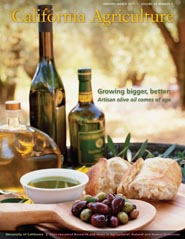All Issues

Growing bigger, better: Artisan olive oil comes of age
Cover:
The California olive industry
has undergone striking changes
in recent years. An internationally
certified sensory taste panel has raised
the quality of California olive oils,
creating new markets (page 8); the
nonnative, invasive olive fruit fly has
transformed pest control for oil and
table olives (pages 14, 21 and 29); and
super-high-density hedgerow plantings
have contributed to increased oil
olive acreage (page 34). Photo: Lisa
Romerein.
January-March 2011
Volume 65, Number 1
Volume 65, Number 1





